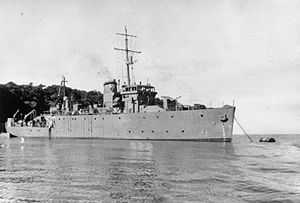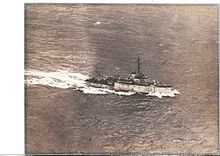HMS Peterhead (J59)
 | |
| Career (United Kingdom) | |
|---|---|
| Name: | HMS Peterhead |
| Builder: | Blyth Shipbuilding Company, Blyth, Northumberland |
| Laid down: | 15 February 1940 |
| Launched: | 31 October 1940 |
| Commissioned: | 11 September 1941 |
| Fate: |
Damaged by a mine on 8 June 1944 Sold for scrapping on 1 January 1948 Scrapped May 1948 |
| General characteristics | |
| Class and type: | Bangor-class minesweeper |
| Displacement: | 656 tons |
| Length: | 174 ft (53.0 m) |
| Beam: | 28.5 ft (8.7 m) |
| Draught: | 8.25 ft (2.5 m) |
| Propulsion: | Two Admiralty 3-drum water tube boilers two shafts coupled to steam turbines 2,000 shp (1,500 kW) |
| Speed: | 16 knots (30 km/h) |
| Complement: | 60 |
| Armament: |
|
HMS Peterhead was a reciprocating-engined Bangor class minesweeper of the Royal Navy. So far she has been the only ship of the Royal Navy named after the Scottish town of Peterhead.
She was built by Blyth Shipbuilding Company, of Blyth, Northumberland and launched on 31 October 1940.
Under the command of Lt Cdr David Croom-Johnson RNVR (later Lord Justice Croom-Johnson), she took part in Operation Neptune, the assault phase of the invasion of Normandy and was mined off Utah Beach on 8 June 1944. Croom-Johnson was awarded a Distinguished Service Cross for Peterhead’s work in Operation Neptune. Peterhead was declared a total loss, and was sold for scrapping on 1 January 1948. She was broken up at Hayes, of Pembroke in May 1948.

HMS Peterhead in the Bay of Biscay on 30 December 1943, taken from a Sunderland flying boat
References
- Colledge, J. J.; Warlow, Ben (2006) [1969]. Ships of the Royal Navy: The Complete Record of all Fighting Ships of the Royal Navy (Rev. ed.). London: Chatham Publishing. ISBN 978-1-86176-281-8. OCLC 67375475.
- HMS Peterhead at uboat.net
- Daily Telegraph Obituary for Sir David Croom-Johnson
| ||||||||||||||||||